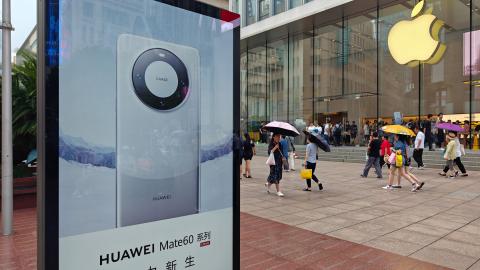Huawei’s recent release of a device with 7 nanometer (nm) semiconductor chips is making headlines. Some consider the Chinese company’s newest smartphone to be a sign that China has broken the technology bottleneck caused by the United States’ export bans, which forbid firms that use US technology and equipment from selling chips to Huawei. Chinese state media touted Huawei’s launch of new devices that contain advanced chips as a sign that the country had successfully “broken US sanctions,” “achieved technological independence” in making advanced chips, and “realized the rejuvenation of the Chinese nation.”
It should be no surprise that Huawei can assemble devices with 7nm chips provided by China’s largest chip producer—Semiconductor Manufacturing International Corporation (SMIC). As early as 2020, SMIC announced its major breakthrough in the production of 7nm chips. But this achievement was made possible by copying Taiwan Semiconductor Manufacturing Corporation (TSMC)’s 7nm process technology.
In addition, before the US export control took effect, Huawei stockpiled semiconductors from overseas, including 7nm chips from TSMC. TSMC’s quarterly management report reckoned that China’s contribution to the company’s total revenue jumped from 11 percent in 2017 to 20 percent in 2019, implying that China rushed to purchase chips from TSMC before the ban took effect. However, three years after the ban, China’s impact on TSMC’s total revenue shrank back to 12 percent in the second quarter of 2023.
Without the continuous supply of advanced chips from TSMC, Huawei is reliant on SMIC’s chips for its cutting-edge devices. But American export bans, which forbid Dutch chip equipment producer ASML from selling extreme ultraviolet (EUV) lithography to China, have made it very costly for SMIC to fabricate chips. According to SMIC’s financial report, its “profit from operation” in the second quarter of 2023 fell to negative 85.2 percent year-on-year, a significant downfall compared to 0.3 percent in the second quarter of 2022 and over 700 percent in 2021.
SMIC’s chips are also lower quality. SMIC’s yield rate for 7nm chips is less than 50 percent, and some estimate that the ratio could be as low as 15 percent. In comparison, using EUV, TSMC’s yield rate for 7nm chips is 80 percent. Due to the enormous difficulty of producing EUV by itself, the current ban on exporting EUV to China has choked off the country’s technological advancement.
Despite these difficulties, the Chinese government is doing its utmost to support Huawei. The government reportedly gave Huawei a $30 billion subsidy to help build semiconductor plants. Beijing is also promoting Huawei in developing countries. Venezuelan President Maduroendorsed the new Mate 60 during his recent visit to China.
To further boost Huawei’s sales, the Chinese government is sabotaging Apple. Beijing had previously ordered government officials not to bring iPhones to the office or use them for work. A few days after Huawei’s release of its new device, it was reported that the ban extended to local government officials and state-owned enterprise employees. The latest notice of prohibition also included the Apple Watch and AirPod wireless earphones.
As Huawei’s sales plunged in the years following the chip ban, Apple’s share in China’s smartphone market increased significantly from 8 percent in the second quarter of 2020 to 20 percent in the first quarter of 2023. During the same period, Chinese companies OPPO, VIVO, and Xiaomi’s combined market share crept from 42 percent to 46 percent. In other words, Apple alone captured Huawei’s lost market share. Now the Chinese government is trying to help Huawei take it back. But sales based on “nationalistic fever” are unlikely to be sustainable.
More importantly, China’s strategy of “working alone behind closed doors” will have another severe impact on the Chinese economy. Apple already decided to cut its production capacity in China by relocating part of its iPhone production to India and part of its MacBook production to Vietnam in the next few years. Apple’s potentially diminished market share following the ban on its devices for Chinese public sector workers might further accelerate the company’s relocation of its factories to other developing countries. Samsung’s closure of all of its smartphone factories in China after the sharp decline of its smartphone sales in the country is a precedent.
China’s already struggling economy would be severely damaged if Apple moved its production. In 2022, 49 out of Apple’s 186 global suppliers were based in mainland China. Several million Chinese people work within Apple’s supply chain network. And Apple’s largest contract manufacturer, Foxconn, has long been among the top-exporting companies in China. Apparently, China values its capability to produce high-technology products over its exports and domestic employment.
In an internal speech in August 2022, Huawei CEO Ren Zhengfei deemed “survival” the company’s chief short-term goal in the face of mounting challenges. Clearly, US export controls on chips and chip-making equipment have put Huawei’s smartphone business in a life-or-death scenario.
Should a government use its full strength to help a company survive at the expense of the whole country’s economic prosperity? The logical answer is an emphatic “no.”



















